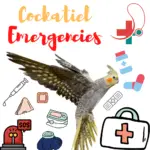
Parasitosis in cockatiel: Parasites in birds The blood-sucking mite or bird mite
The red louse that most commonly appears in aviary birds is the red bird mite or blood-sucking mite called Dermanyssus gallina. It is a small beast, barely visible to the naked eye, which looks like a spider.
Giardosis of the cockatiel
Giardia is a protozoan of mammals, birds, and amphibians infesting the intestines by protecting themselves with cystic envelopes. Giardia psittaci and Giardia ardeae are specific to birds. The cyst then passes into the stool which represents the first place of contamination. Giardiasis is a zoonosis, which means that it is transmissible from bird to bird, but also to other animal species such as humans.
One of the fundamental points of the preventive fight against giardiasis is the hygiene of drinking troughs and water points of birds. Indeed, by contaminating water and food with their droppings, birds easily spread protozoa. Cysts containing protozoan can withstand two weeks in the external environment. High temperatures, overcrowding of aviaries, or even the age of animals are factors that promote pathology.
Symptoms include significant stress or depressive behavior, itching leading to pecking, pruritus on the top of the legs and flanks, diarrhea (soft or smelly liquid feces dirty the tail feathers and legs of the animal), and strong weight loss accompanied by depression. The mortality rate is high following a significant risk of liver complications in cockatiels. No drug was fully effective.
Note that half of California’s population of cockatiels and wavy parakeets is infested with Giardia sp.
Scabies in cockatiel
Scabies is a common parasitosis of birds. It is a mite whose female digs into the skin of its host to lay its eggs. Scabies can therefore reach the entire body of the animal in the thickness of the epidermis, under the scales, or in the follicles of the feathers. But it is noticeable in particular at the level of the head, beak, and legs. Scabies, feeding on the keratin of the scales, is a source of itching for the bird that scratches abnormally.
Pruritus forms around its beak and on its legs, kinds of scaly proliferations that thicken and take on a yellowish color and more or less pile up. At an advanced stage, scabies can attack the germ matrix of the beak and cause deformations of the maxillae, cracks, or significant elongation.
It is important to quickly treat all birds in case of diagnosis of scabies with a suitable anti-parasitic. The weakest birds can lose phalanges or even fingers in case of untreated infection in time. Contamination can take place from bird to bird but also through the accessories of the cage.
The duration of the development cycle is 2 weeks. The bird can be a healthy carrier of effect and trigger it during stress. Other birds may remain unharmed in a contaminated group, and the theory of a deficiency of the immune system is considered.
Cockatiel mites
Mites may be responsible for other different effects of scabies in cockatiels. They are sometimes called “pseudo-scabies”. Thus, Megninia cubitalis causes alopecia spots on the body of the animal with pruritus. Other mites cause oval or round and flat nodules sometimes resembling grains of rice on the body of the bird.
The “red louse” is also a mite: Dermanyssus gallinae. It is bloodsucking and therefore feeds on the blood of its hosts, hence their particular color, and causes lesions, pruritus, and in the worst case anemia. The cockatiel is particularly contaminated by wild birds such as pigeons, so birds living in outdoor aviaries are more affected. They can be visible to the naked eye or by stroking the animal to “turn back” over a white cloth.
Calopistte coccidiose
It is a parasite of the digestive tract that attacks the most vulnerable animals (the young, the old, the sick). The cockatiel withers loses weight strongly, or cannot gain weight, and is affected by diarrhea that can be bloody.
Candidiasis of the cockatiel
Candidiasis is sometimes called thrush and is caused by mycosis in the digestive tract. This fungus, naturally present in the digestive tract as yeast in the saprophytic state, sometimes grows in abnormal quantities and is rejected and thus contaminating the external environment. The birds then ingest it and the fungus proliferates in the beak and crop. Stress, malnutrition, decreased immunity, long-term antibiotic therapy or even poor hygiene can promote candidiasis. Humidity and acidity are sometimes blamed for thrush as well. Affected birds are anorexic because they have difficulty feeding, have diarrhea, and have mouth and tongue lesions. White caseous matter forms on the mucous membranes of the animal and throwing can be observed.
Trombiculosis of the cockatiel
Caused by the larva of august, trombiculosis leads to pruritus and sometimes vestibular syndrome if the larva enters the animal’s ear canal. The presence of the Augustat is easily identifiable: orange larvae are visible to the naked eye. Cockatiels living in outdoor aviaries are more likely to be affected during the summer.
The tick of the cockatiel
The cockatiel is more frequently a victim of the soft tick and this fact remains rather rare. Ticks usually bite at the level of the head and can cause many symptoms such as toxin shock, edema, weakened inflammation, and the hemorrhagic area around the bite … Ticks should be removed properly so as not to leave the oral parts in the body of the bird.
The louse of the cockatiel
Cockatiel lice, dermanyssus gallinae, are visible to the naked eye. They like to nest especially in areas that are difficult for the bird to access: the head, rump, or under the wings. They cause irritation because of their mallophagous activity. The bird is nervous and restless, it develops crusts, pruritus, erythema, and sometimes pecking. His feathers become brittle. Lice are especially attracted to old, sick, or weakened individuals. The activity of the louse is nocturnal.
Ringworm in cockatiel
Ringworm is a skin fungus, so it is caused by a fungus, Trichophyton. Rare in birds, however, it is a zoonosis. While the direct transmission is the most common (from bird to bird), indirect transmission (from the environment to the bird) is possible. The diagnosis is made thanks to culture on Sabourraud medium.
Treating Worms in Birds
SOURCE:Vetafarm




















